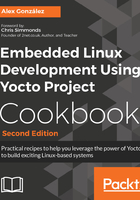
There's more...
The FSL community BSP extends Poky with the following layers:
- meta-freescale: This is the community layer that supports NXP reference designs. It has a dependency on OpenEmbedded-Core. Machines in this layer will be maintained even after NXP stops active development on them. You can download meta-freescale from its Git repository at http://git.yoctoproject.org/cgit/cgit.cgi/meta-freescale/.
Development discussions can be followed and contributed to by visiting the development mailing list at https://lists.yoctoproject.org/listinfo/meta-freescale.
The meta-freescale layer provides both the i.MX6 Linux kernel and the U-Boot source either from NXP's or from FSL community BSP maintained repositories using the following links:
-
- NXP's Linux kernel Git repository: http://git.freescale.com/git/cgit.cgi/imx/linux-imx.git/
- FSL community Linux kernel Git repository: https://github.com/Freescale/linux-fslc.git
- NXP's U-Boot Git repository: http://git.freescale.com/git/cgit.cgi/imx/uboot-imx.git/
- FSL community U-Boot Git repository: https://github.com/Freescale/u-boot-fslc.git
Other Linux kernel and U-Boot versions are available, but keeping the manufacturer's supported version is recommended.
The meta-freescale layer includes NXP's proprietary binaries to enable some hardware features—most notably its hardware graphics, multimedia, and encryption capabilities. To make use of these capabilities, the end user needs to accept the NXP End-User License Agreement (EULA), which is included in the meta-freescale layer.
- meta-freescale-3rdparty: This layer adds support for other community-maintained boards, for example, the Wandboard. To download the layer's content, you may visit https://github.com/Freescale/meta-freescale-3rdparty/.
- meta-freescale-distro: This layer adds a metadata layer for demonstration target images. To download the layer's content, you may visit https://github.com/Freescale/meta-freescale-distro.
This layer adds two different sets of distributions, one maintained by the FSL BSP community (fslc- distributions) and one maintained by NXP (fsl- distributions). They are a superset of Poky that allows you to easily choose the graphical backend to use between:
-
- framebuffer
- x11
- Wayland
- XWayland
We will learn more about the different graphical backends in Chapter 4, Application Development.
NXP uses another layer on top of the layers previously mentioned for their official software releases:
- meta-fsl-bsp-release: This is an NXP-maintained layer that is used in the official NXP software releases. It contains modifications to both meta-freescale and meta-freescale-distro. It is not part of the community release but can be accessed at http://git.freescale.com/git/cgit.cgi/imx/meta-fsl-bsp-release.git/.
